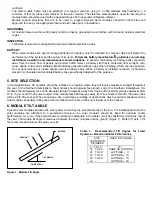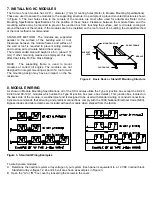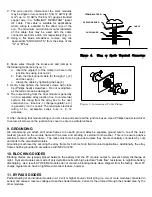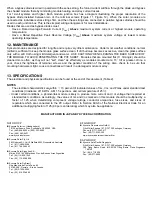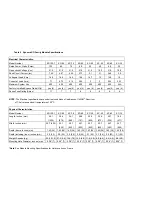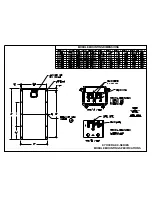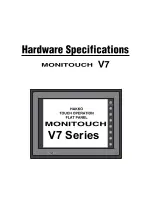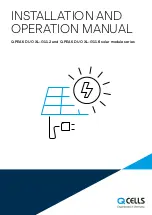
C. The wire used to interconnect the solar modules
may be single or two conductor, from 14 AWG (2.08
mm
2
) up to 10 AWG (5.26 mm
2
) gauge stranded
copper wire, in a “SUNLIGHT RESISTANT” jacket
UF cable. This cable is suitable for applications
where wiring is exposed to the direct rays of the
sun. The maximum and minimum outer diameters
of the cable that may be used with the cable
connector are 8 mm and 6 mm respectively (Fig. 3).
D. Using a flat blade screwdriver, remove only the
appropriate "KNOCK-OUTS" from the sides of the
"G" or "M" box .
CABLE
CUP WASHER
SPRING WASHER
TERMINAL SCREW
Figure 4. Ring or Spade Terminal Connectors
E. Route wires through the knock-outs and clamps in
the following steps (see
Figure 5
):
a. Insert the nipple (1) of the clamp in a hole in the
junction box using lock nut (2).
b. Push the interconnect cable (3) through (1), (2)
and the cap (4).
c. Clamp the cable by tightening the cap (4).
F. Gently hand tighten the terminal screws with cross
tip (Phillips head) screwdriver. Do not overtighten,
as the terminal can be damaged.
G. The output wiring from the final module is generally
run to a separate array junction box. In commercial
system, this wiring from the array box to the next
component (i.e. fuse box. or charge regulator, etc.)
is generally run in conduit. The maximum electrical
rating of an acceptable series fuse is 4
~
12
amperes.
Figure 5. Interconnect Cable Clamp
H. After checking that module wiring is correct, close and secure all the junction boxes. Use a Phillips head screw driver
to secure all screws on the junction box cover to ensure a waterproof seal.
9. GROUNDING
We recommend you attach all module frames to an earth ground. Attach a separate ground wire to one of the holes
marked
‘
ground
’
on the module frame with a screw and bonding or external tooth washer. This is to ensure positive
electrical contact with the frame. The racks must also be grounded unless they are mechanically connected by nuts
and bolts to the grounded modules.
Grounding is achieved by securing the array frame for both roof and field mounted applications. Additionally, the array
frame shall be grounded in accordance with NEC Art 250.
10. BLOCKING DIODES
Blocking diodes are typically placed between the battery and the PV module output to prevent battery discharge at
night. Kyocera modules are made of polycrystalline cells with high electrical
“
back flow
”
resistance to nighttime battery
discharging. As a result, KYOCERA modules do not contain a blocking diode when shipped from the factory. Most PV
charge regulators do have a nighttime disconnect feature, however.
11. BYPASS DIODES
Partial shading of an individual module in a 12 volt or higher source circuit string (i.e. two or more modules connected in
series) can cause a reverse voltage across the shaded module. Current is then forced through the shaded area by the
other modules.


